V-ing作状语讲课教案
- 格式:ppt
- 大小:2.50 MB
- 文档页数:37
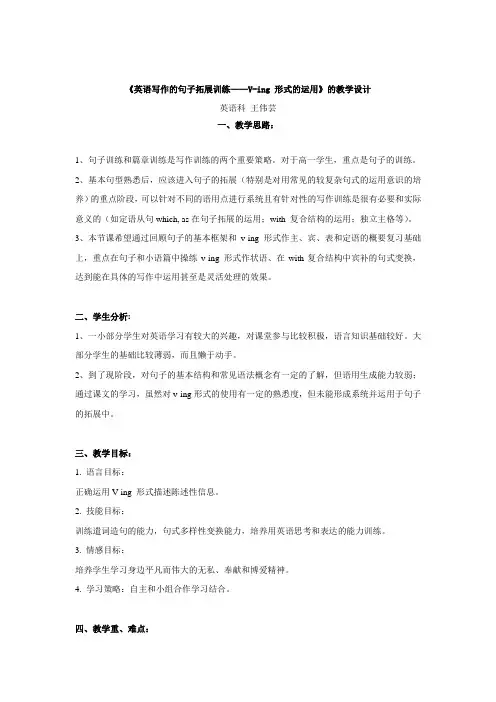
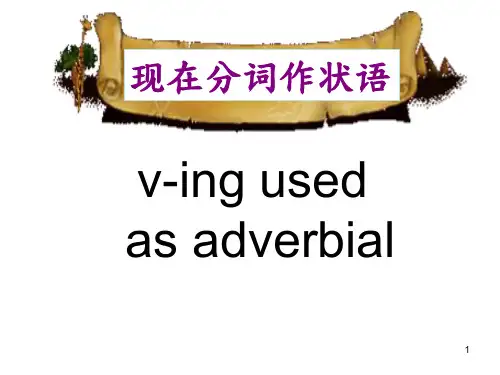
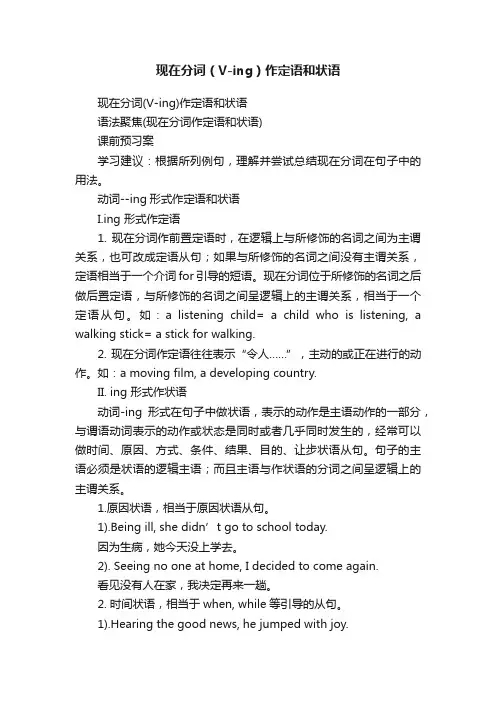
现在分词(V-ing)作定语和状语现在分词(V-ing)作定语和状语语法聚焦(现在分词作定语和状语)课前预习案学习建议:根据所列例句,理解并尝试总结现在分词在句子中的用法。
动词--ing形式作定语和状语I.ing 形式作定语1. 现在分词作前置定语时,在逻辑上与所修饰的名词之间为主谓关系,也可改成定语从句;如果与所修饰的名词之间没有主谓关系,定语相当于一个介词for引导的短语。
现在分词位于所修饰的名词之后做后置定语,与所修饰的名词之间呈逻辑上的主谓关系,相当于一个定语从句。
如:a listening child= a child who is listening, a walking stick= a stick for walking.2. 现在分词作定语往往表示“令人……”,主动的或正在进行的动作。
如:a moving film, a developing country.II. ing 形式作状语动词-ing形式在句子中做状语,表示的动作是主语动作的一部分,与谓语动词表示的动作或状态是同时或者几乎同时发生的,经常可以做时间、原因、方式、条件、结果、目的、让步状语从句。
句子的主语必须是状语的逻辑主语;而且主语与作状语的分词之间呈逻辑上的主谓关系。
1.原因状语,相当于原因状语从句。
1).Being ill, she didn’t go to school today.因为生病,她今天没上学去。
2). Seeing no one at home, I decided to come again.看见没有人在家,我决定再来一趟。
2. 时间状语,相当于when, while等引导的从句。
1).Hearing the good news, he jumped with joy.当听到这个好消息时,他高兴地跳了起来。
2).Walking in the street, I saw a friend of mine.当我走在街上时,我看到了我的朋友。
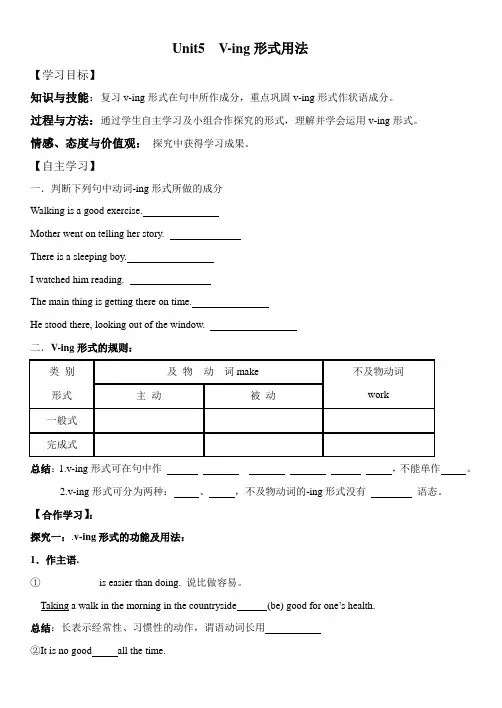
Unit5 V-ing形式用法【学习目标】知识与技能:复习v-ing形式在句中所作成分,重点巩固v-ing形式作状语成分。
过程与方法:通过学生自主学习及小组合作探究的形式,理解并学会运用v-ing形式。
情感、态度与价值观:探究中获得学习成果。
【自主学习】一.判断下列句中动词-ing形式所做的成分Walking is a good exercise.Mother went on telling her story.There is a sleeping boy.I watched him reading.The main thing is getting there on time.He stood there, looking out of the window.二.V-ing形式的规则:总结:1.v-ing形式可在句中作,不能单作。
2.v-ing形式可分为两种:、,不及物动词的-ing形式没有语态。
【合作学习】:探究一:.v-ing形式的功能及用法:1.作主语.①___________ is easier than doing. 说比做容易。
Taking a walk in the morning in the countryside (be) good for one’s health.总结:长表示经常性、习惯性的动作,谓语动词长用②It is no good all the time.A. complaining B complained C. Complain D. to complain总结:句中it作,把真正的主语-- 移置句尾,但仅限于以下结构中可以这样用:It is no use\ no good\ doing sth (尽可能多写)提示:当动名词用作主语时,其逻辑主语由形容词性物主代词和名词所有格构成。
1. 我姐姐病了,使我很担心。
being ill made we worried.2. to the station on time made everyone worried last week.A. Him not gettingB. Not his gettingC. His not gettingD. Not getting2. 作宾语(1)常跟在某些动词后作宾语E.g I remember (lock) the door before I left the office, but forget to turn off the lights.(2)常跟在某些动词短语后作宾语E.g He insisted on (walk) to school everyday.(3)常用在某些句型中作宾语:E.g I have difficulty in (learn) English well.(4)I found no use .(和他谈话)总结:有时用作形式宾语,而把真正宾语置于句尾。
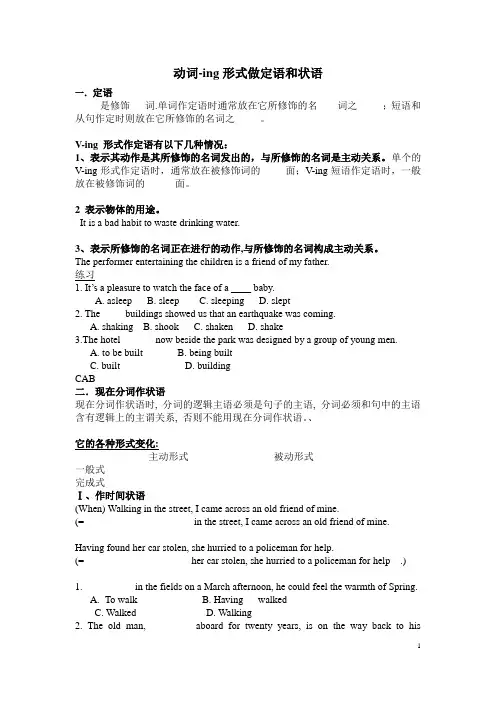
动词-ing形式做定语和状语一.定语是修饰___词.单词作定语时通常放在它所修饰的名词之_____;短语和从句作定时则放在它所修饰的名词之_____。
V-ing 形式作定语有以下几种情况:1、表示其动作是其所修饰的名词发出的,与所修饰的名词是主动关系。
单个的V-ing形式作定语时,通常放在被修饰词的_____面;V-ing短语作定语时,一般放在被修饰词的______面。
2 表示物体的用途。
It is a bad habit to waste drinking water.3、表示所修饰的名词正在进行的动作,与所修饰的名词构成主动关系。
The performer entertaining the children is a friend of my father.练习1. It’s a pleasure to watch the face of a ____ baby.A. asleepB. sleepC. sleepingD. slept2. The ____ buildings showed us that an earthquake was coming.A. shakingB. shookC. shakenD. shake3.The hotel ______ now beside the park was designed by a group of young men.A. to be builtB. being builtC. builtD. buildingCAB二.现在分词作状语现在分词作状语时, 分词的逻辑主语必须是句子的主语, 分词必须和句中的主语含有逻辑上的主谓关系, 否则不能用现在分词作状语。
、它的各种形式变化:主动形式被动形式一般式________________ __________________完成式________________ __________________Ⅰ、作时间状语(When) Walking in the street, I came across an old friend of mine.(=______________________in the street, I came across an old friend of mine.Having found her car stolen, she hurried to a policeman for help.(= _____________________her car stolen, she hurried to a policeman for help .)1.__________ in the fields on a March afternoon, he could feel the warmth of Spring.A.To walkB. Having walkedC. WalkedD. Walking2. The old man, ________ aboard for twenty years, is on the way back to hismotherland.A.to workB. workingC. to have workedD. having worked在逻辑上,当动词-ing形式表示的动作和句子谓语动词表示的动作同时发生时用_____________________;在句子谓语动词表示的动作之前发生时用___________________________.答案:V-ing being V-edhaving V-ed having been V-edWhen I was walkingAfter she found her car stolenDDⅡ、作原因状语Being ill, he didn’t go to school(=_________________________, he didn’t go to school.)Being a student, you should study hard.(=Since you are a student, you should study hard.)Not thinking he might be at home, I called him.(=As I didn’t think he might be at home, I called him.)1. ____ a reply, he decided to write again.(NMET92)A.Not receivingB. Receiving notC. Not having receivedD. Having not received2. ______ his telephone number, she had somedifficulty getting in touch with Bill. (1991上海)A.Not knowingB. knowing notC. Not having knownD. Having not known表示原因的动词-ing 形式一般放于句首,相当于一个原因状语从句。
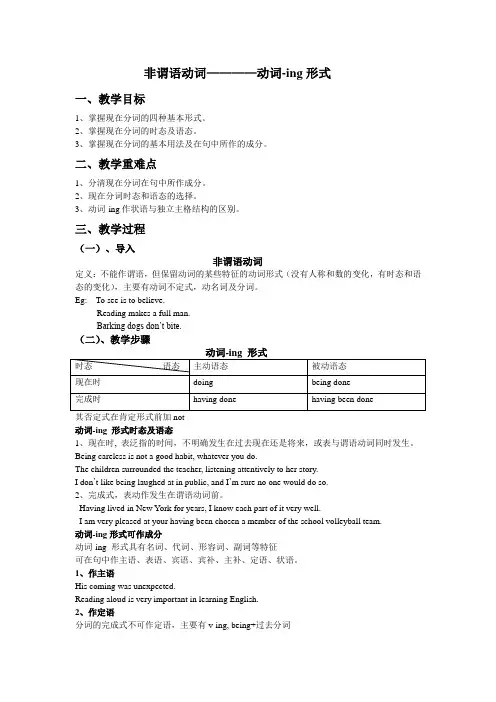
非谓语动词————动词-ing形式一、教学目标1、掌握现在分词的四种基本形式。
2、掌握现在分词的时态及语态。
3、掌握现在分词的基本用法及在句中所作的成分。
二、教学重难点1、分清现在分词在句中所作成分。
2、现在分词时态和语态的选择。
3、动词-ing作状语与独立主格结构的区别。
三、教学过程(一)、导入非谓语动词定义:不能作谓语,但保留动词的某些特征的动词形式(没有人称和数的变化,有时态和语态的变化),主要有动词不定式,动名词及分词。
Eg: To see is to believe.Reading makes a full man.Barking dogs don’t bite.(二)、教学步骤动词-ing 形式时态语态主动语态被动语态现在时doing being done完成时having done having been done其否定式在肯定形式前加not动词-ing 形式时态及语态1、现在时, 表泛指的时间,不明确发生在过去现在还是将来,或表与谓语动词同时发生。
Being careless is not a good habit, whatever you do.The children surrounded the teacher, listening attentively to her story.I don’t like being laughed at in public, and I’m sure no one would do so.2、完成式,表动作发生在谓语动词前。
Having lived in New York for years, I know each part of it very well.I am very pleased at your having been chosen a member of the school volleyball team.动词-ing形式可作成分动词-ing 形式具有名词、代词、形容词、副词等特征可在句中作主语、表语、宾语、宾补、主补、定语、状语。
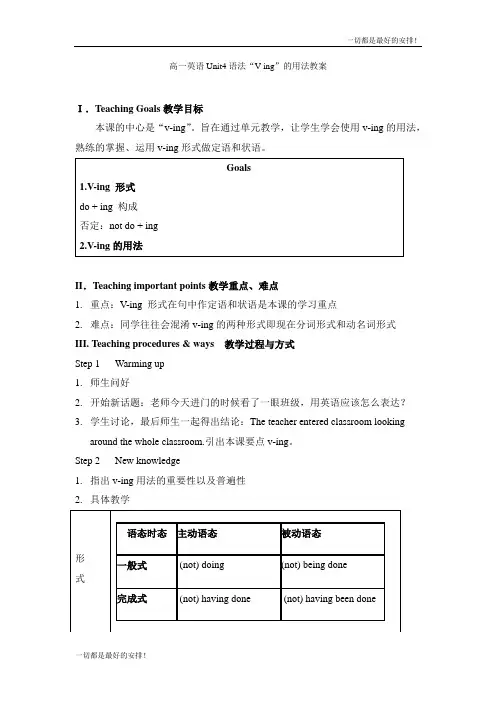
高一英语Unit4语法“V-ing”的用法教案I.Teaching Goals教学目标本课的中心是“v-ing”。
旨在通过单元教学,让学生学会使用v-ing的用法,熟练的掌握、运用v-ing形式做定语和状语。
II.Teaching important points教学重点、难点1.重点:V-ing 形式在句中作定语和状语是本课的学习重点2.难点:同学往往会混淆v-ing的两种形式即现在分词形式和动名词形式III. Teaching procedures & ways 教学过程与方式Step 1 Warming up1.师生问好2.开始新话题:老师今天进门的时候看了一眼班级,用英语应该怎么表达?3.学生讨论,最后师生一起得出结论:The teacher entered classroom lookingaround the whole classroom.引出本课要点v-ing。
Step 2 New knowledge1.指出v-ing用法的重要性以及普遍性2.具体教学Step 3 Practice1.通过翻译老师给出的句子或同学自由发挥造句练习本课要点2.通过练习题来练习本课要点练习题一、改写句子1.You see her step back and she appears surprised. = You see her step backappearing surprised.2.His nose touched Mr. Cook’s hand which is moving. = His nose touched Mr.Cook’s moving hand.3.They are visitors who come from several countries. =They are visitors comingfrom several countries.4.This is an experience which is exciting. =This is an exciting experience.二、填空1.When he approached Ms Smith, he touched her shoulder and kissed her.______ ___________ Ms Smith, he touched her shoulder and kissed her.(When approaching)2. The person who is translating the songs can speak seven languages.The person _________ ___ ______can speak seven languages.(translating the songs)3. The boy standing there is reading a book about body language.The boy ____ __ ________ there is reading a book about body language.(who is standing)4. Because he comes from Jordan, he moves close to ask you a question._______ _____ Jordan, he moves close to ask you a question.(Coming from)5. She sat at the desk and did her homework.She sat at the desk ______ ____ __________.(doing her homework)三、选择A 1. The stranger said something in a _______ voice and the little girl was verymuch ________A. frightening, frightenedB. frightened, frighteningC. frightening, frighteningD. frightened, frightenedB 2. ________the piano, someone suddenly knocked at the door.A. PlayingB. When I was playingC. RepairingD. ExaminingD 3. Mother caught the boy ______ in the corner.A. smokeB. to smokeC. being smokedD. smokingC 4. ______ the programme, they have to stay there for another 2 weeks..A. Not completingB. Not completedC. Not having completedD. Having not completedA 5. “We can’t go out in this weather”, said Bob, ____ out of the window.A. lookingB. to lookC. lookedD. having lookedKey: A B D C A。
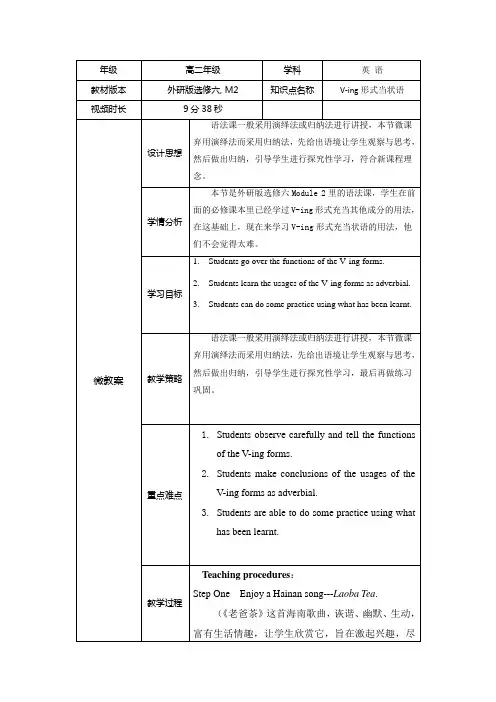
Step Seven Consolidation .1.–ing形式一般式表示该动作与谓语动作同时发生或与谓语动作紧接着发生,完成式则表示该动作发生在谓语动作之前,在句中只能作状语表示时间和原因。
2. –ing形式的主动式表示该动作是由句子主语发出,而被动式表示主语承受该动作。
3. –ing形式的否定式是在一般式和完成式的前面加not(never)。
4. –ing形式可以与when, while, if, though, once, until 等连词和介词on连用。
5. –ing形式在句中作状语时可表示时间、原因、条件、伴随状况和结果等。
通常可以改为相应的从句或并列句。
(本步骤让学生把刚学过的动词ing形式的几种情况进行再次总结,以加深印象,为下一步的应用做好准备。
)Step Eight Practice Activity 3 at Page 18 of the textbook. Match the two parts of the sentences:(本步骤让学生运用所学知识进行简单的操练,旨在让学生加深与巩固所学知识,符合新课程理念。
)Step Nine Practice again. Activity 3 at Page 21 of the textbook. Rewrite the sentences with the --ing forms of the verbs.e.g: When he returns to the palace, the king marries the woman.On returning to the palace, the king marries the woman.1.When he saw the witch, the boy ran away.2. Before he starts the war, the king speaks to the prince.3. While he was fighting in the war, the prince learnt many things.4. After he had spoken to his son, the king went to war.5. Because he doesn’t know what to do, Ferdinand follows the frog’s advice.(学生练习后,给出对照答案:)1.On seeing the witch, the boy ran away.。

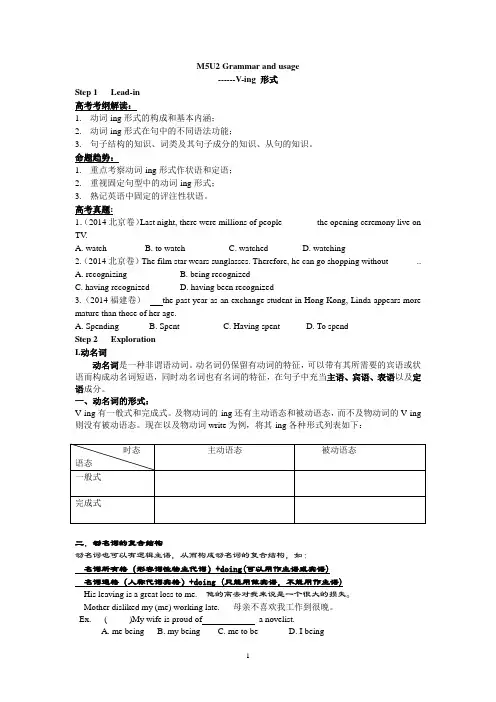
M5U2 Grammar and usage------V-ing 形式Step 1 Lead-in高考考纲解读:1.动词-ing形式的构成和基本内涵;2.动词-ing形式在句中的不同语法功能;3.句子结构的知识、词类及其句子成分的知识、从句的知识。
命题趋势:1.重点考察动词-ing形式作状语和定语;2.重视固定句型中的动词-ing形式;3.熟记英语中固定的评注性状语。
高考真题:1.(2014北京卷)Last night, there were millions of people _______ the opening ceremony live on TV.A. watchB. to watchC. watchedD. watching2.(2014北京卷)The film star wears sunglasses. Therefore, he can go shopping without ______..A. recognizingB. being recognizedC. having recognizedD. having been recognized3.(2014福建卷)the past year as an exchange student in Hong Kong, Linda appears more mature than those of her age.A. SpendingB. SpentC. Having spentD. To spendStep 2 ExplorationI.动名词动名词是一种非谓语动词。
动名词仍保留有动词的特征,可以带有其所需要的宾语或状语而构成动名词短语,同时动名词也有名词的特征,在句子中充当主语、宾语、表语以及定语成分。
一、动名词的形式:V-ing有一般式和完成式。
及物动词的-ing还有主动语态和被动语态,而不及物动词的V-ing 则没有被动语态。
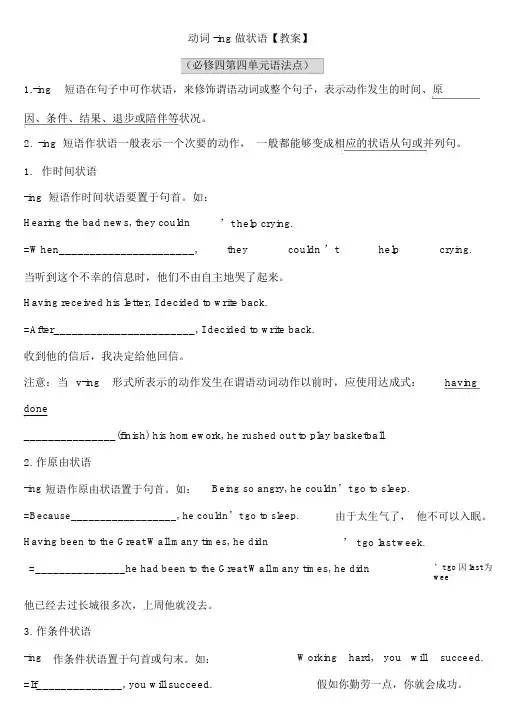
动词 -ing 做状语【教案】(必修四第四单元语法点)1.-ing短语在句子中可作状语,来修饰谓语动词或整个句子,表示动作发生的时间、原因、条件、结果、退步或陪伴等状况。
2.-ing 短语作状语一般表示一个次要的动作,一般都能够变成相应的状语从句或并列句。
1.作时间状语-ing 短语作时间状语要置于句首。
如:Hearing the bad news, they couldn’t help crying.=When______________________,they couldn’t help crying.当听到这个不幸的信息时,他们不由自主地哭了起来。
Having received his letter, I decided to write back.=After_______________________, I decided to write back.收到他的信后,我决定给他回信。
注意:当v-ing形式所表示的动作发生在谓语动词动作以前时,应使用达成式:having done_______________(finish) his homework, he rushed out to play basketball.2. 作原由状语-ing短语作原由状语置于句首。
如:Being so angry, he couldn’t go to sleep.=Because__________________, he couldn’t go to sleep.由于太生气了,他不可以入眠。
Having been to the Great Wall many times, he didn’ t go last week.=_______________he had been to the Great Wall many times, he didn’t go因last为wee他已经去过长城很多次,上周他就没去。